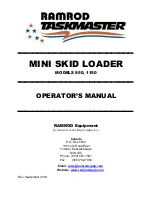
III-101
2. Condenser
Condensers get dirty and the dirt reduces heat movement by insulating the con-
denser. The fittings come loose or break from stress if the condenser or connecting
hoses are not secured properly to keep the effects of vibration at a minimum.
Heat transfer efficiency and pressure in the condenser are affected by the
amount of outside air flowing through condenser fins. A lack of air flow can mean
the refrigerant doesn
·
t give up enough heat energy to the outside air (it doesn
·
t
change state). The refrigerant arrives at the evaporator as a gas and can
·
t pick up
any heat energy from cab air. In the cab, air from the vents is only slightly cool
or warm.
One possible cause of condenser malfunction could be the engine cooling sys-
tem. This is why fan clutches and radiator shutters are often controlled or over-
ridden by AC switch function. In fact, we can add fan clutch, radiator shutters and
also fan motors to condenser problems. If they don
·
t function to allow sufficient
air through the condenser, pressure inside the system may become dangerously
high. A lack of air through the condenser fins can raise high side pressure and
blow out the weakest point in a system, or damage the compressor.
3. Refrigerant Lines, Hoses and Fittings
Problems with these parts may be caused by normal deterioration, vibration dam-
age, lack of maintenance or human error (improper installation or replacement).
All rubber parts are attacked by ozone (oxygen) in the air. Rubber parts break
down slowly and become more vulnerable to the effects of vibration with the
passage of time.
Heavy duty vehicle vibration causes stress on all lines, fittings and connections.
Regular maintenance includes checking and tightening any suspect line, or hose
retainers, or grommet position where the grommet is protecting a line or hose
from abrasion. Any insulating material wrapped around hoses must be in place
and securely fastened.
4. Refrigerant Metering Valves
When you consider valve problems there are obvious differences in valve con-
struction and what can go wrong. If a valve is clogged with sludge or other
obstruction, the result is a valve problem but the cause is contamination in the
system. Valves get stuck open or closed, although most often closed when the
gas charge is lost from the diaphragm housing in a traditional TXV. The capillary
tube can vibrate loose from the evaporator outlet tube. The capillary can break
and the small quantity of temperature sensitive gas can escape. The diagnosis of
a valve as defective calls for replacement.
5. Other Problems—Leaks, Moisture, and Adding
Refrigerant
Before any refrigerant was put inside the AC system, someone used a vacuum
pump to evacuate any air and moisture. Vacuum is really a force pulling against
all hoses, fittings and components from the inside. When the system is charged
with refrigerant, the pressure goes from minus (a vacuum) to plus pressure inside
the hoses and all components. The refrigerant and refrigeration oil are trying to
escape from the system at all times.
Troubleshooting & Service Procedures
Summary of Contents for TL150
Page 1: ...TL150 Track Loader BOOK No CT7E901 WORKSHOP MANUAL Serial No 21500004...
Page 4: ...0 4...
Page 5: ...I 1 I GENERAL...
Page 18: ...I 14 GENERAL...
Page 19: ...II 1 II SPECIFICATIONS...
Page 44: ...III 1 III MACHINE CONFIGURATION...
Page 94: ...III 51 MACHINE CONFIGURATION ELECTRICAL SYSTEM ELECTRICAL SYSTEM ELECTRICAL WIRING DIAGRAM...
Page 122: ...III 79...
Page 146: ...MACHINE CONFIGURATION III 103...
Page 147: ...IV 1 IV HYDRAULIC UNITS...
Page 152: ...IV 6 HYDRAULIC UNITS HST PUMP 1 Plug 2 Plug 3 Plug 4 Screw 5 Seal Nut 6 Plug Pump Assembly 4 4...
Page 189: ...IV 43 HYDRAULIC UNITS GEAR PUMP INSPECTION AND ADJUSTMENT IV 36 38 TROUBLESHOOTING IV 39...
Page 230: ...IV 84 HYDRAULIC UNITS PILOT VALVE INSPECTION AND ADJUSTMENT IV 79 TROUBLESHOOTING IV 80...
Page 261: ...IV 115 HYDRAULIC UNITS TRAVEL MOTOR DISASSEMBLY AND ASSEMBLY Special tools...
Page 263: ...IV 117 HYDRAULIC UNITS TRAVEL MOTOR...
Page 282: ...IV 136 HYDRAULIC UNITS TRAVEL MOTOR...
Page 283: ...V 1 V TROUBLESHOOTING...


































